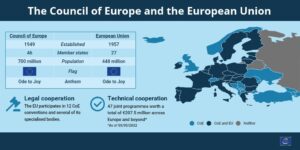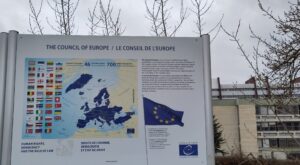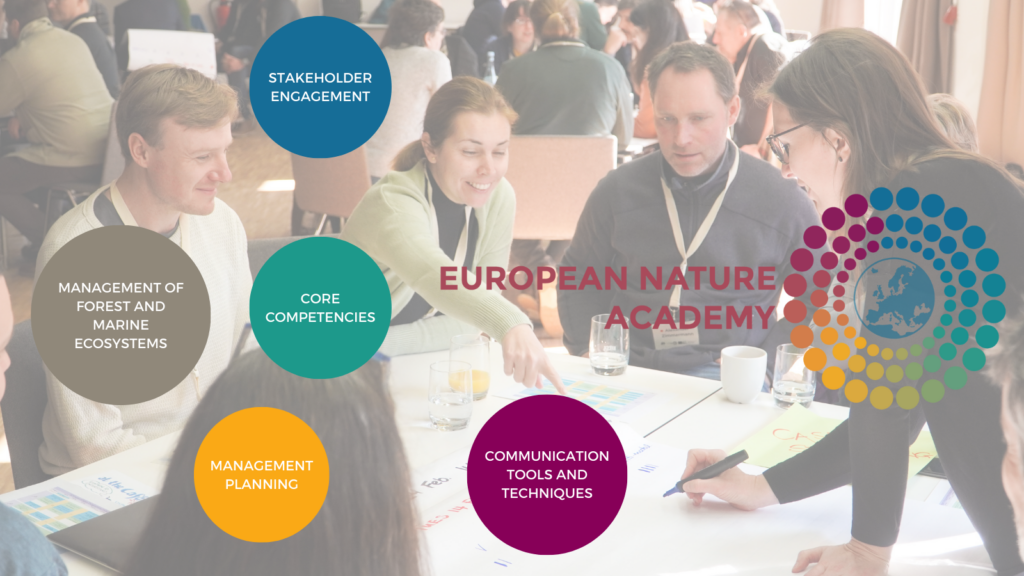The Council of Europe, the “unknown” European institution, crucial for European nature protection
In July 2022, the United Nations recognised that a healthy, and sustainable environment is a human right. The Council of Europe (CoE), the international institution created to promote democracy and protect human rights and the rule of law in Europe, engaged for years to promote European nature and landscape. Its role is now more relevant than ever to guarantee this human right in the continent. Among the 37 States of our EUROPARC members, 36 are members or observers of the Council of Europe. That is why since 2023 the CoE has been a priority of the EUROPARC Brussels’ Office, and why we are publishing a series of articles to present to our members and public the Council of Europe’s work and the EUROPARC commitment as a member of the CoE’s Conference of International Non-Governmental Organisations.
The Council of Europe, the “unknown” European institution, crucial for European nature protection
The Council of Europe was created in 1949, just after the II World War, and today it brings together 46 member states (Russia lost the status of member in 2022). It is based in Strasbourg (FR), its official languages are French and English, and it is a very important and complex institution.
During its long history, the CoE has launched and implemented several initiatives in the sector of “Culture / Cultural Heritage / Nature” that are very crucial for EUROPARC and its members, among which:
- Bern Convention – Convention on the Conservation of European Wildlife and Natural Habitats
- Landscape Convention
- European Heritage Days
- European Diploma of Protected Areas of the Council of Europe
- Landscape Award of the Council of Europe
- Reykjavik Declaration, annex 5
The CoE is also very committed in the Youth involvement, other important topic for EUROPARC.
But… What is the Council of Europe?
This organisation is distinct from the European Union (EU), even if both share the same European flag, the same European anthem, and no country has ever joined the EU without first belonging to the Council of Europe.
As such, it should not be confused with the European Council and the Council of European Union which are EU institutions…

Source: The Council of Europe and the European Union. Available at: coe.int/en/web/portal/european-union.
Already lost? Do not worry, it is normal!
Forget the EU, and just remain concentrated on the Council of Europe. It is the oldest European institution, created to defend human rights and democracy.
The most famous body of CoE is the European Court of Human Rights (ECtHR) which ensures that States respect the European Convention on Human Rights: citizens, and sometimes even States, can appeal to the Court. In the future, this institution could become relevant in case of violations of the right to a healthy environment.
Nevertheless, there are several other CoE bodies that are less known but vital for the CoE’s work. In particular, four institutions composing the so-called CoE “quadrilogue”
- Committee of Ministers
- Parliamentary Assembly (PACE)
- Congress of Local and Regional Authorities
- Conference of International Non-Governmental Organisations (INGOs)
Each of these bodies has a role in the development of environmental protection in Europe.

The Committee of Ministers is the Council of Europe’s decision-making body. It is composed of the Ministers for Foreign Affairs of Member States. Each Member State guarantees the presidency in turn for 6 months. Occasionally, the Council of Europe organizes Summits of the Heads of State and Government, as done in 2023 in Reykjavik, where they adopted the Reykjavík Declaration – United around our values. The Annex 5 of this declaration is devoted to reinforcing the CoE commitment to environmental protection.
Do you know that some members of your national parliaments are also members of the CoE’s Parliamentary Assembly (PACE)? This is indeed the way to guarantee the voice of the representatives elected by citizens inside the CoE. PACE acts as a “motor”, driving forward new ideas and holds a constant dialogue with governments, national parliaments, other international organisations and civil society which “set the agenda”. With the #EnvironmentRightNow: a PACE initiative of the Assembly in 2021, the institutions strongly pushed for the adoption of a healthy environment as a human right.
The Congress of Local and Regional Authorities is a political assembly whose members represent over 150,000 local and regional authorities throughout Europe. It is responsible for strengthening local and regional democracy in its 46 member states. As the voice of Europe’s municipalities and regions, it works to foster consultation and political dialogue between national governments and local and regional authorities, through cooperation with the Committee of Ministers. Clearly, for all our work connected with regional and natural Protected Areas, as well as Periurban parks, this institution could become a relevant interlocutor.
Last but not least, the Conference of International Non-Governmental Organisations (INGOs). Independent non-governmental organisations are a vital component of European society, guaranteeing freedom of expression and association, fundamental for a functioning democracy. International NGOs (INGOs) have therefore the opportunity to acquire CoE participatory status and become a member of the Conference. Since 2016, its role has increased through a stronger dialogue and collaboration with the other 3 institutions of the “quadrilogue”. The Conference of INGOs meets in its General Assembly twice a year and works in Committees on priority themes. EUROPARC is an active member of the Conference, is part of several working groups and led for 2 years the – Environment, Climate Change, Heritage & Health Committee (ECCH&H).
In the next articles, we will start to explore the CoE’s work and commitment to the environment, as well as its relevant Conventions to discover their importance for the European Protected Areas and the role that EUROPARC and its members can play in promoting and implementing them.
Stay tuned!
EUROPARC Federation and Rewilding Europe to promote wilder parks
Europe’s extensive network of Protected Areas play a vital role in conserving the continent’s natural beauty, flora and fauna. An exciting new partnership between Rewilding Europe and the EUROPARC Federation will help many to create the enabling conditions for wilder nature, delivering essential benefits for people, biodiversity and climate.
Protection and restoration
Protected areas are the backbone of European nature. With more than 120,000 sites designated across Europe, including the 27,000 sites of the Natura 2000 network, such areas cover nearly 1.2 million square kilometres, equating to an area the size of France and Spain combined.
Many of Europe’s protected areas contain unique and frequently awe-inspiring repositories of biodiversity. Yet, simply protecting the nature they currently contain isn’t enough. It’s not enough to halt and reverse biodiversity decline, and it’s not enough to slow and stop climate change. With the geographical extent of such areas so large, there is now a fantastic opportunity to build on the conservation efforts being carried out within them, enhancing the invaluable nature they already contain through rewilding. By focusing on the restoration of natural processes, and working to support and scale up the comeback of European wildlife species that is already happening in many parts of the continent, we can really amplify the benefits such areas deliver, such as clean air, fresh water, and the locking up of atmospheric carbon.
Towards wilder parks

Frans Schepers
In fantastic news for European nature, and for Europeans, a new partnership agreement entitled “Wilder Parks” has just been signed between Rewilding Europe and the EUROPARC Federation – the largest network of European Protected Areas. It will enable Rewilding Europe and the EUROPARC Federation to work together to support and showcase the work of Protected Areas that are already making great progress in restoring nature, and to inspire others, in the wider landscape, to follow their lead. The initiative will help to make the protected areas of the EUROPARC membership, which account for around 40% of the Natura 2000 network, wilder.
“This new partnership has hugely exciting potential,” says Rewilding Europe Executive Director Frans Schepers, who co-signed the agreement with Michael Hošek, EUROPARC President, at our annual Conference celebrating on October 4. “Many European protected areas are already doing a great job in rewilding, but there is wide-ranging scope for others to follow suit. This is where Rewilding Europe can help.”
“I’m delighted to establish this professional cooperation with Rewilding Europe,” adds Michael Hošek.

Michael Hošek
EUROPARC, thanks to its broad and diverse membership base, has significant experience in Protected Area management. We always aim to support our members, and to use measures that are best for protected areas, in collaboration with communities and stakeholders, to enable natural processes to thrive. The cooperation and exchange of experience with Rewilding Europe will benefit both parties.
Letting nature lead
There are a wide range of rewilding measures that Europe’s Protected Areas can employ to create the right conditions for nature recovery. These include allowing forests to naturally regenerate, removing dams and restoring natural water regimes, more natural wildlife management, enhancing natural grazing, leaving carcasses in nature, improving connectivity, reintroducing keystone species, and many more – all with the aim of restoring natural processes and food webs. In conjunction, these measures help to enhance the health, connectivity, functionality and resilience of natural ecosystems. Working with communities and stakeholders across such areas.
The work carried out under the new agreement will include learning from EUROPARC members that are already carrying out rewilding measures, and enabling them to share their knowledge with others. Additional Protected Areas which are keen to apply rewilding principles will be identified, with Rewilding Europe offering them training, resources, and opportunities for knowledge exchange. Access to Rewilding Europe’s European Wildlife Comeback Fund, for example, could help some to start or scale up the reintroduction of keystone species, where appropriate.
Specific activities will be agreed and laid out in a shared work plan which will be finalised next year. These will include the development of joint fundraising proposals, which will aim to secure additional funding for the Wilder Parks initiative.
Meeting commitments
In December 2022, leaders of European countries agreed to adopt the historic Kunming-Montreal Global Biodiversity Framework, which includes a global target to restore 30% of degraded ecosystems globally by 2030. This commitment will contribute to the EU’s own restoration agenda, and obligations of EU Member States under the new Nature Restoration Law, which was approved by the European Parliament in July and is currently in the final negotiation stage.
It’s clear that Protected Areas play an important role in fulfilling the commitments nations made to nature in 2022
says Rewilding Europe’s Head of Upscaling Amy Duthie. “This new partnership, with Rewilding Europe and EUROPARC working together to enable the development of wilder parks, will help to realise a wilder Europe where each country fulfils its biodiversity and climate commitments, for the benefit of both people and nature.”
Want to know more?
European Nature Academy: Apply now!
ARE YOU READY TO BE ENABLED?
Get the skills and training you need to become more effective, competent and confident nature managers!
About LIFE ENABLE & the European Nature Academy (ENA)
Natura 2000 and Protected Area managers work in a wide variety of roles, in multidisciplinary settings. Where you work is likely to be dynamic, constantly evolving and complex.
You routinely face challenges and opportunities in your daily work, which require you to apply a special mix of knowledge, skills and attitudes. In almost all cases, as well as technical conservation skills, you need to work inclusively, in cooperation with local communities and other organisations: in this, you need to be able to communicate what you are doing and why. The management choices you make and the ways in which you work are critical to achieving progress towards your objectives for nature.
LIFE ENABLE is designed to meet Natura 2000 and Protected Area managers’ training needs. It is creating the new European Nature Academy (ENA) to provide tailor-made training and support your professional development.
The goal is to contribute to ensuring progress towards the realisation of the objectives and ambitions of the EU Biodiversity Strategy 2030 and underpinning policies.
To achieve this, the ENA’s cost-free training courses focus on the competencies required to manage Natura 2000 and Protected Areas more effectively.
Who should apply?
At this stage, we are looking for 100 individuals working currently in Protected Areas across Europe. Once selected, you will become part of the ENA and enroll as participants to the courses.
The courses focus on core competencies, including stakeholder engagement, communication tools and techniques and management planning. Specific attention is also given to management of forest and marine ecosystems, so we are giving priority to managers of these habitat types, especially in Natura 2000 sites. When you apply, simply let us know which habitat type is of more interest to you – either forest or marine, but you can’t pick both!

Whatever your area of work, we will welcome your application. People of all ages and backgrounds, working in diverse roles in a Natura 2000 site or Protected Area can apply – for example:
- Managers in either governmental or non- governmental organisations.
- People working in national, regional or natural parks (which also include Natura 2000 sites), for example Rangers.
- Individuals working for a local authority or public administration with responsibilities for nature conservation and protection.
- Individuals working as a specialist ecologist or in nature conservation policy.
- People working with local communities – for example, as environmental educators, communication specialists, volunteer or visitor managers, or individuals with responsibilities for interpretation, nature-based sustainable development, legal advisors, land stewardship etc.
- Private landowners of a Natura 2000 site or other entrepreneurs in a Protected Area – for example, with farming, forestry, fishing or tourism interests.
How the European Nature Academy works…
The new European Nature Academy is a training hub and provides access to a series of practical capacity building courses for nature’s managers. The courses are designed specifically to equip individuals and their organisations with the competencies they require to meet the challenges and opportunities of nature management in the coming decade.
Delivered in a series of online modules and networking events, the emphasis is on applied learning to improve management practices and ways of working for Natura 2000 & Protected Areas across Europe. The modules focus on the core skills, knowledge & attitudes you need in your daily work.
The competence-based modules cover the following subjects:
- Tools for participative and inclusive governance
- Design of communication strategies, tools, techniques and approaches
- Management planning as a technical process for biodiversity conservation & a process for social engagement
- Strategies for engagement, collaborative working, conflict management, resolution & mediation